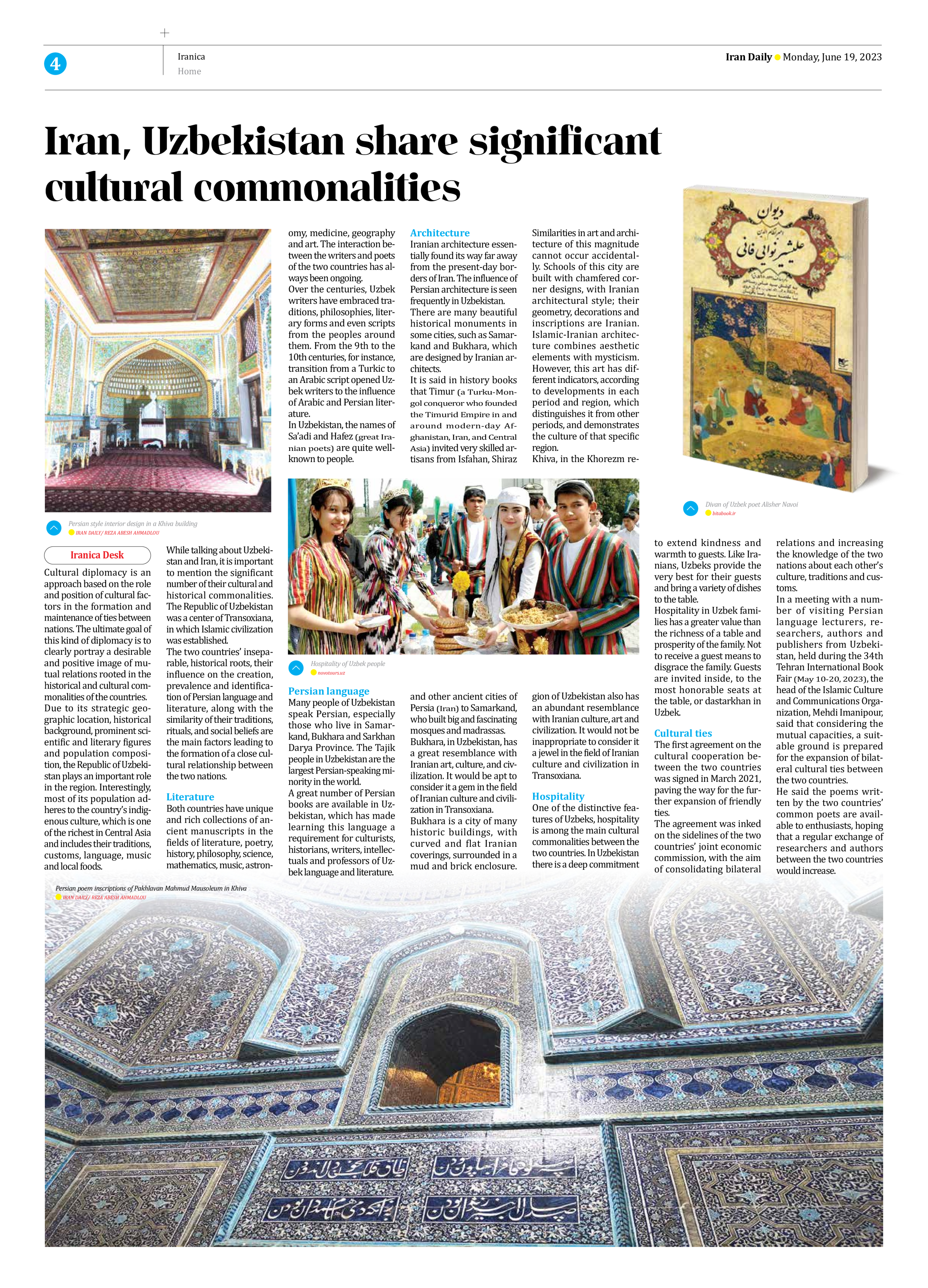
Iran, Uzbekistan share significant cultural commonalities
Cultural diplomacy is an approach based on the role and position of cultural factors in the formation and maintenance of ties between nations. The ultimate goal of this kind of diplomacy is to clearly portray a desirable and positive image of mutual relations rooted in the historical and cultural commonalities of the countries.
Due to its strategic geographic location, historical background, prominent scientific and literary figures and population composition, the Republic of Uzbekistan plays an important role in the region. Interestingly, most of its population adheres to the country’s indigenous culture, which is one of the richest in Central Asia and includes their traditions, customs, language, music and local foods.
While talking about Uzbekistan and Iran, it is important to mention the significant number of their cultural and historical commonalities. The Republic of Uzbekistan was a center of Transoxiana, in which Islamic civilization was established.
The two countries’ inseparable, historical roots, their influence on the creation, prevalence and identification of Persian language and literature, along with the similarity of their traditions, rituals, and social beliefs are the main factors leading to the formation of a close cultural relationship between the two nations.
Literature
Both countries have unique and rich collections of ancient manuscripts in the fields of literature, poetry, history, philosophy, science, mathematics, music, astronomy, medicine, geography and art. The interaction between the writers and poets of the two countries has always been ongoing.
Over the centuries, Uzbek writers have embraced traditions, philosophies, literary forms and even scripts from the peoples around them. From the 9th to the 10th centuries, for instance, transition from a Turkic to an Arabic script opened Uzbek writers to the influence of Arabic and Persian literature.
In Uzbekistan, the names of Sa’adi and Hafez (great Iranian poets) are quite well-known to people.
Persian language
Many people of Uzbekistan speak Persian, especially those who live in Samarkand, Bukhara and Sarkhan Darya Province. The Tajik people in Uzbekistan are the largest Persian-speaking minority in the world.
A great number of Persian books are available in Uzbekistan, which has made learning this language a requirement for culturists, historians, writers, intellectuals and professors of Uzbek language and literature.
Architecture
Iranian architecture essentially found its way far away from the present-day borders of Iran. The influence of Persian architecture is seen frequently in Uzbekistan.
There are many beautiful historical monuments in some cities, such as Samarkand and Bukhara, which are designed by Iranian architects.
It is said in history books that Timur (a Turku-Mongol conqueror who founded the Timurid Empire in and around modern-day Afghanistan, Iran, and Central Asia) invited very skilled artisans from Isfahan, Shiraz and other ancient cities of Persia (Iran) to Samarkand, who built big and fascinating mosques and madrassas.
Bukhara, in Uzbekistan, has a great resemblance with Iranian art, culture, and civilization. It would be apt to consider it a gem in the field of Iranian culture and civilization in Transoxiana.
Bukhara is a city of many historic buildings, with curved and flat Iranian coverings, surrounded in a mud and brick enclosure.
Similarities in art and architecture of this magnitude cannot occur accidentally. Schools of this city are built with chamfered corner designs, with Iranian architectural style; their geometry, decorations and inscriptions are Iranian.
Islamic-Iranian architecture combines aesthetic elements with mysticism. However, this art has different indicators, according to developments in each period and region, which distinguishes it from other periods, and demonstrates the culture of that specific region.
Khiva, in the Khorezm region of Uzbekistan also has an abundant resemblance with Iranian culture, art and civilization. It would not be inappropriate to consider it a jewel in the field of Iranian culture and civilization in Transoxiana.
Hospitality
One of the distinctive features of Uzbeks, hospitality is among the main cultural commonalities between the two countries. In Uzbekistan there is a deep commitment to extend kindness and warmth to guests. Like Iranians, Uzbeks provide the very best for their guests and bring a variety of dishes to the table.
Hospitality in Uzbek families has a greater value than the richness of a table and prosperity of the family. Not to receive a guest means to disgrace the family. Guests are invited inside, to the most honorable seats at the table, or dastarkhan in Uzbek.
Cultural ties
The first agreement on the cultural cooperation between the two countries was signed in March 2021, paving the way for the further expansion of friendly ties.
The agreement was inked on the sidelines of the two countries’ joint economic commission, with the aim of consolidating bilateral relations and increasing the knowledge of the two nations about each other’s culture, traditions and customs.
In a meeting with a number of visiting Persian language lecturers, researchers, authors and publishers from Uzbekistan, held during the 34th Tehran International Book Fair (May 10-20, 2023), the head of the Islamic Culture and Communications Organization, Mehdi Imanipour, said that considering the mutual capacities, a suitable ground is prepared for the expansion of bilateral cultural ties between the two countries.
He said the poems written by the two countries’ common poets are available to enthusiasts, hoping that a regular exchange of researchers and authors between the two countries would increase.







